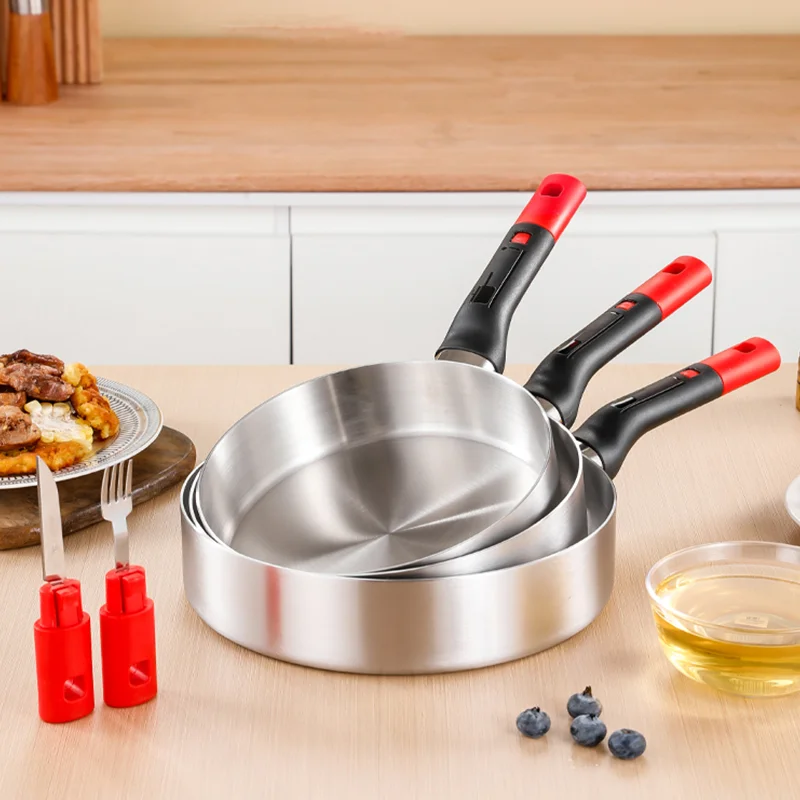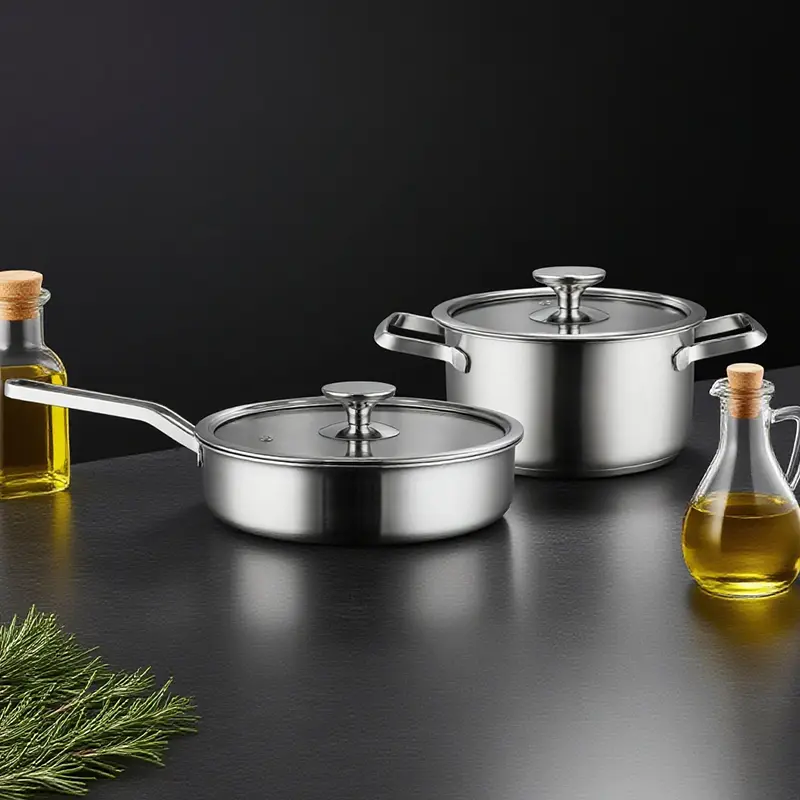If you’re building a home kitchen, equipping a professional production line, or purchasing retail products, consider stainless steel cutlery. One thing is certain: stainless steel cookware offers durability, safety, and long-term value.
Como fabricante profissional de utensílios de cozinha, Purecook will help you understand the true value of stainless steel kitchenware.
Core Advantages of Stainless Steel Kitchenware
Durability & Longevity
Well-made stainless steel kitchenware is difficult to scratch, dent, or deform. Unlike thin aluminum pots or coated non-stick pots, high-quality stainless steel cookware is resistant and durable to bear commercial usage and heavy usage, so that you can reduce replacements and save more time.
Food Safety, Non-reactivity
Food-grade stainless steel (304/18-10,316 suitable for harsher conditions) will not react with acidic ingredients. This means that whether slow-simmering tomatoes or scraping residue off the bottom of the pot, there will not be a metallic smell or toxic residue left behind, and the performance is reliable.
Versatility Across Heat Sources
Most stainless steel cookware can be used on ceramic stoves, electric stoves, gas stoves, and induction cookers. It is thus convenient to plan the kitchen, being very well placed in commercial and multi-kitchen environments.

Carefully Designed to Heat More Evenly
The multi-layer or three-layer setup (stainless steel, aluminum, stainless steel) best combines the food safety top of stainless steel with aluminum or copper cores, with the ability to provide quick and even heat circulation, thereby reducing hotspots and also lowering fuel consumption.
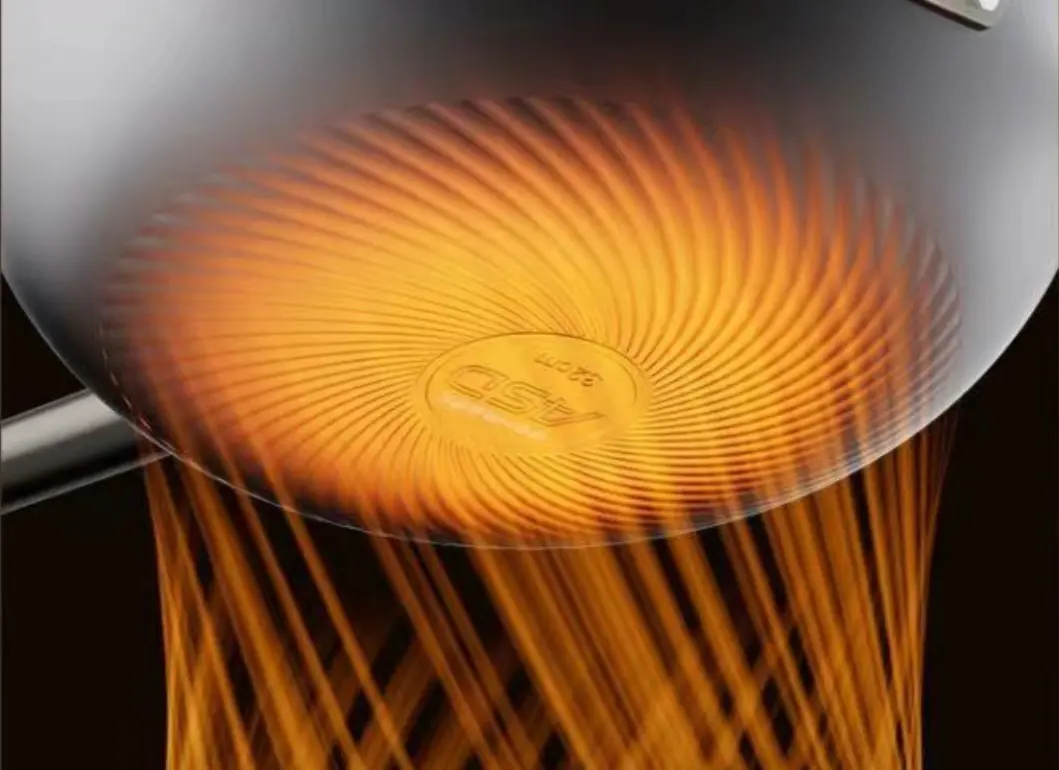
Sustainability and Total Cost of Ownership
Due to the recyclability and long lifespan of stainless steel, its total cost of ownership (TCO) is typically enhanced over less expensive options once maintenance, replacement, and downtime are considered.
Anatomy of Quality Stainless Steel Kitchenware
There are different specifications of stainless steel kitchenware on the market, but good stainless steel kitchenware shall have the characteristics mentioned below. During purchase, kindly observe the following specifications:
Grau do material: For normal usage in the kitchen, please use 304 material (usually marked as 18/8 or 18/10 in chromium/nickel content). Where exposed to salt or caustic chemicals on a regular or frequent basis, stainless steel kitchenware made from 316 material can be utilized as it provides excellent corrosion resistance.
Construction: For uniform heating (especially for cooking ware such as pots, pans, etc.), please choose a fully wrapped three-layer or five-layer structure. This means that the aluminum or copper thermal conductive core will be brought right up to the sidewall of the pot. If sidewall heating is being addressed, please do not use the “disc wrapping” structure.
Thickness: The general thickness of the coating layer (and core material thickness) will impact thermal stability and insulation. In commercial usage, generally, it is preferable to use materials with greater thickness since they are stronger and more durable.
Edges and handle: Rolled edges of pots and bowls are safer from tipping over and deformation. Handles welded or hollow riveted must be mounted on the furnace body to extend its service life.
Induction compatibility: If you use an electromagnetic stove, please ensure that the bottom of the stainless steel kitchenware has a magnetic coat (usually 430 or ferritic stainless steel).
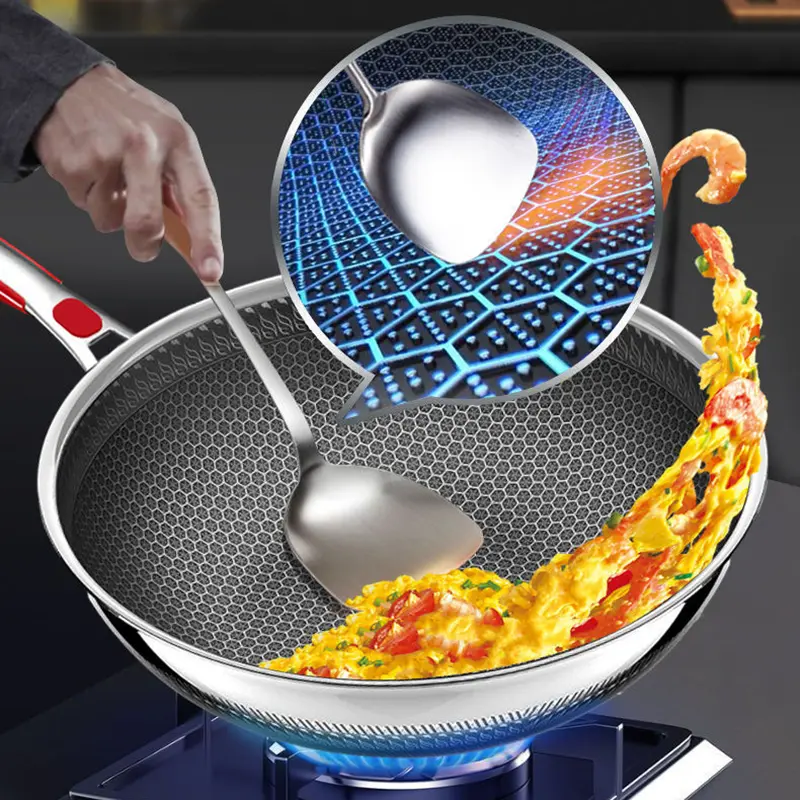
How Stainless Steel VS Other Materials
| Material | Key Advantage over Stainless Steel | Stainless Steel Advantage | Trade-offs of the Material |
| Nonstick | Highly convenient for low-fat cooking and cleanup. | Sears well and allows a fond (browned bits) to form for sauces. | Limits browning/searing; coating can wear out over time. |
| Ferro fundido | Holds heat exceptionally well, ideal for high-heat cooking and retention. | Lighter weight; maintenance-free (no seasoning required); dishwasher tolerant. | Heavy; requires careful seasoning and maintenance to prevent rust. |
| Aluminum/Titanium | Aluminum is very light and responsive to temperature changes. Titanium is ultralight. | Non-reactive with acidic foods (unlike raw aluminum); balanced performance and price for most kitchens. | Raw aluminum reacts with acidic foods; Titanium is typically very expensive. |
Buying Guide: What to Test and Request
For home buyers, a good 3–5 piece set (skillet, sauté, saucepan, stockpot, lid) covers most needs.
For restaurants or retail buyers, include these in RFQs:
- MTR (Mill Test Report) to verify grade and composition.
- Ply count and total thickness (specify mm tolerance).
- Weld and rivet specs (TIG/laser weld preferred; rivets matched to body material).
- Performance tests: warp after X heat cycles, induction efficiency, and thermal uniformity.
Sample test you can run on delivery: fill a pan with 1 L of water, place it on a standard burner, and time to boil; check several surface points for temperature variance—good cookware shows small differences.
Care & Maintenance
- Rinse soon after use; avoid prolonged soaking in chlorinated solutions.
- For stuck food, deglaze with hot water, or simmer water + baking soda before scrubbing.
- Dishwashers are fine for many stainless lines—check manufacturer guidance—but hand-dry to prevent water spots and check rivets.
- Restore shine with occasional electropolish or gentle stainless cleaner if needed.
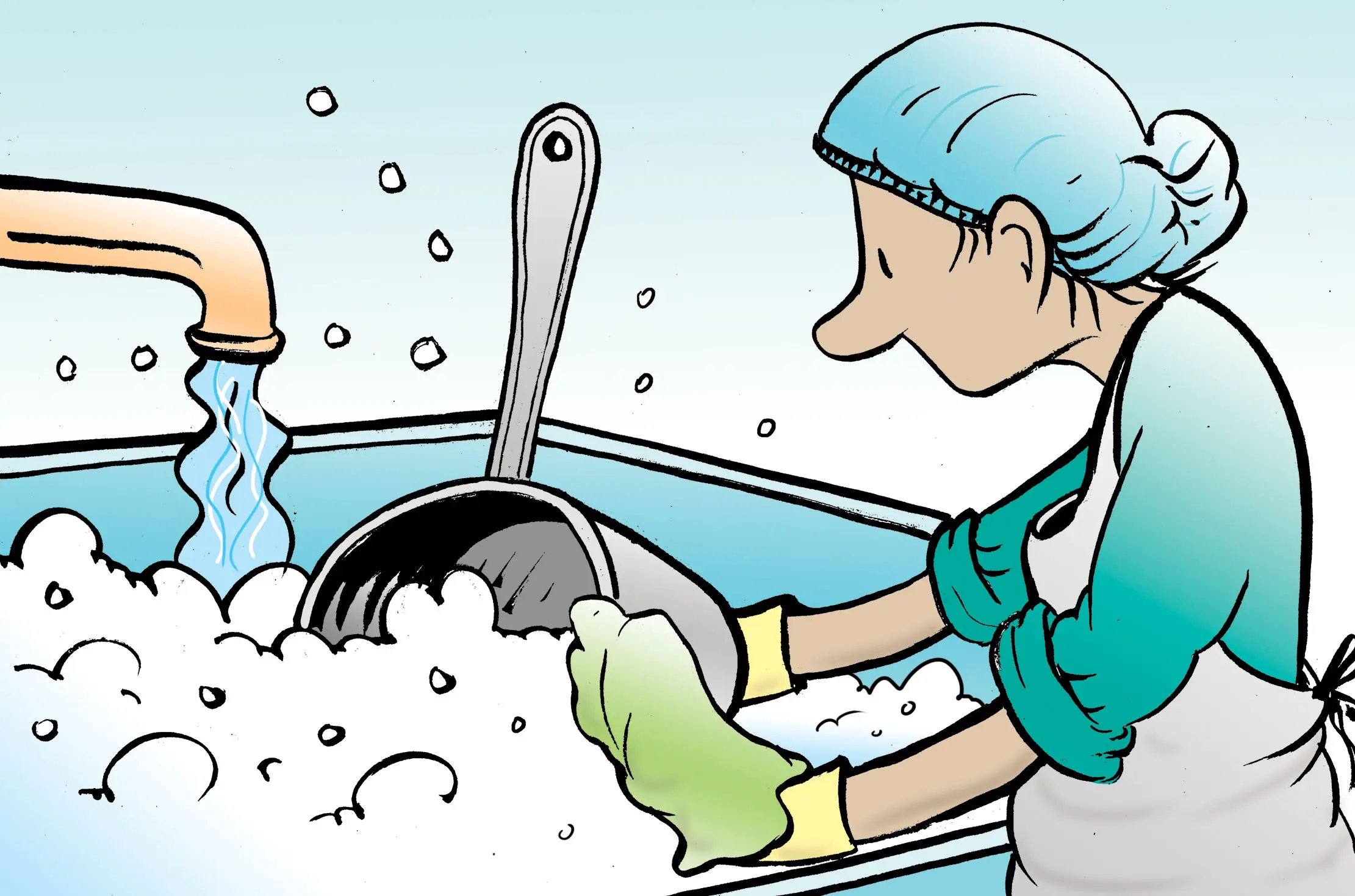
Conclusão
Whether you’re equipping a family kitchen, a food truck, or a hotel line, stainless steel kitchenware is the practical backbone of consistent, safe cooking. It’s not glamorous, but it is reliable—and reliability is the most profitable kind of elegance.
Sobre a Purecook
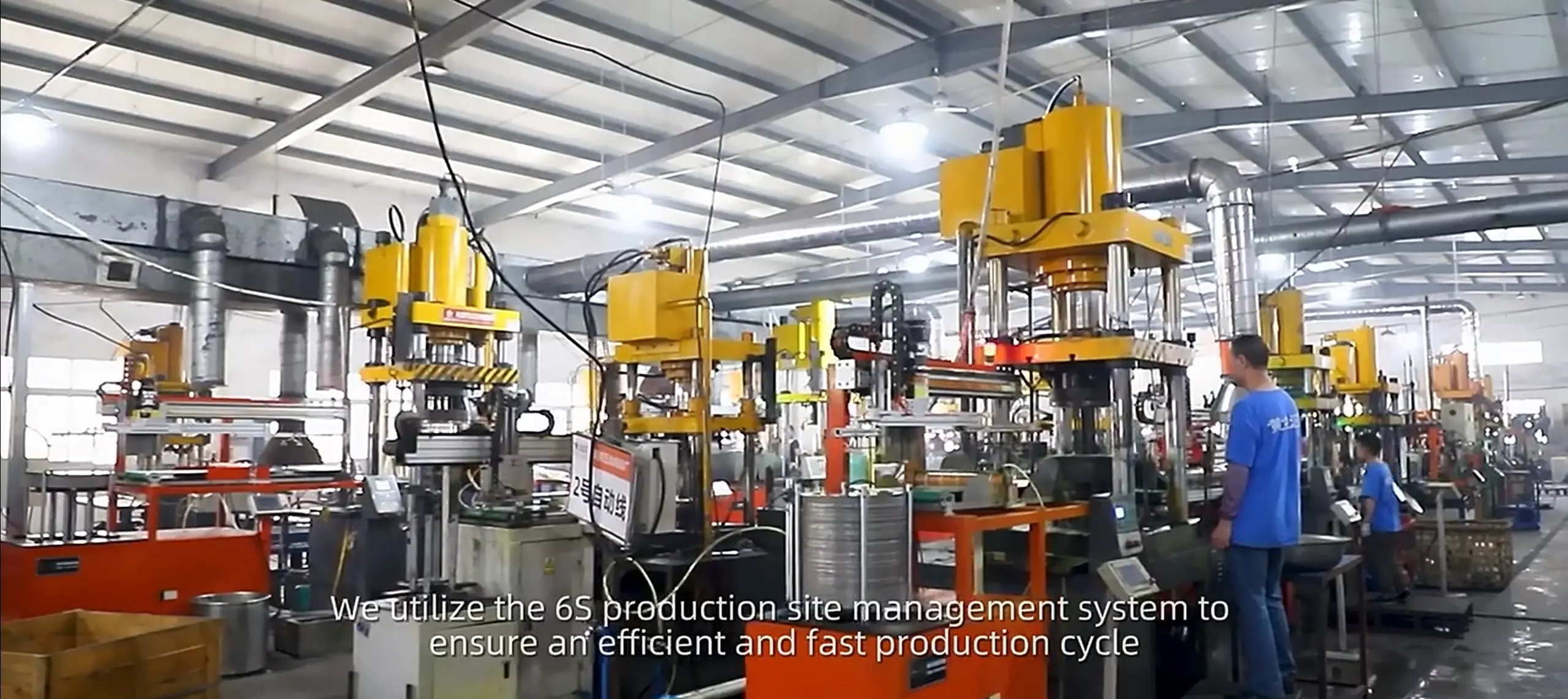
Purecook é um fabricante líder de utensílios de cozinha em aço inoxidável, providing custom stainless steel kitchenware solutions e bulk supply stainless steel kitchenware to global distributors and brands. With automated production lines and efficient management, we ensure fast turnaround, consistent quality, and competitive pricing.
Our factory supports both large-volume and tailored OEM/ODM orders, helping partners expand their product range quickly and confidently in the market.

